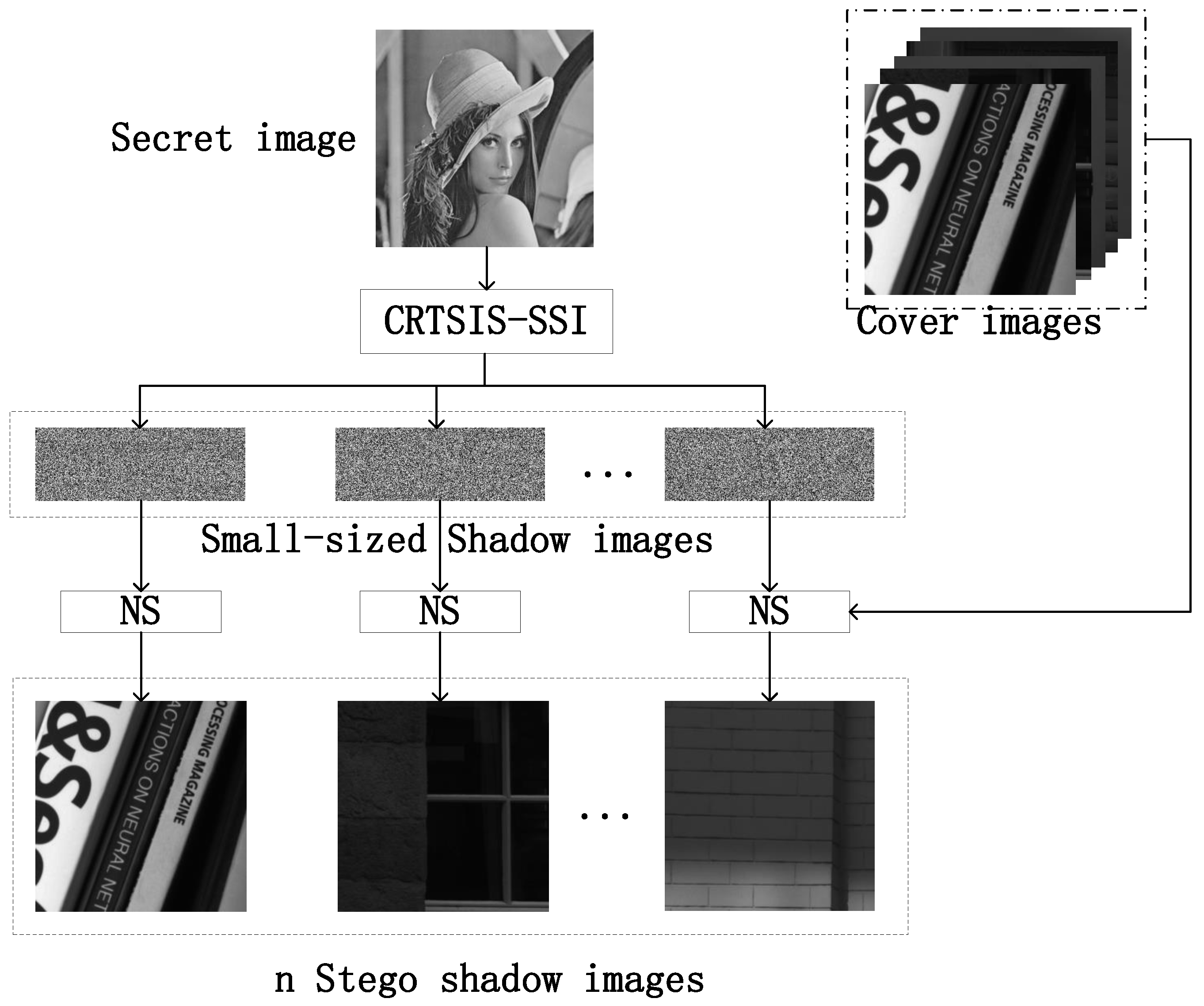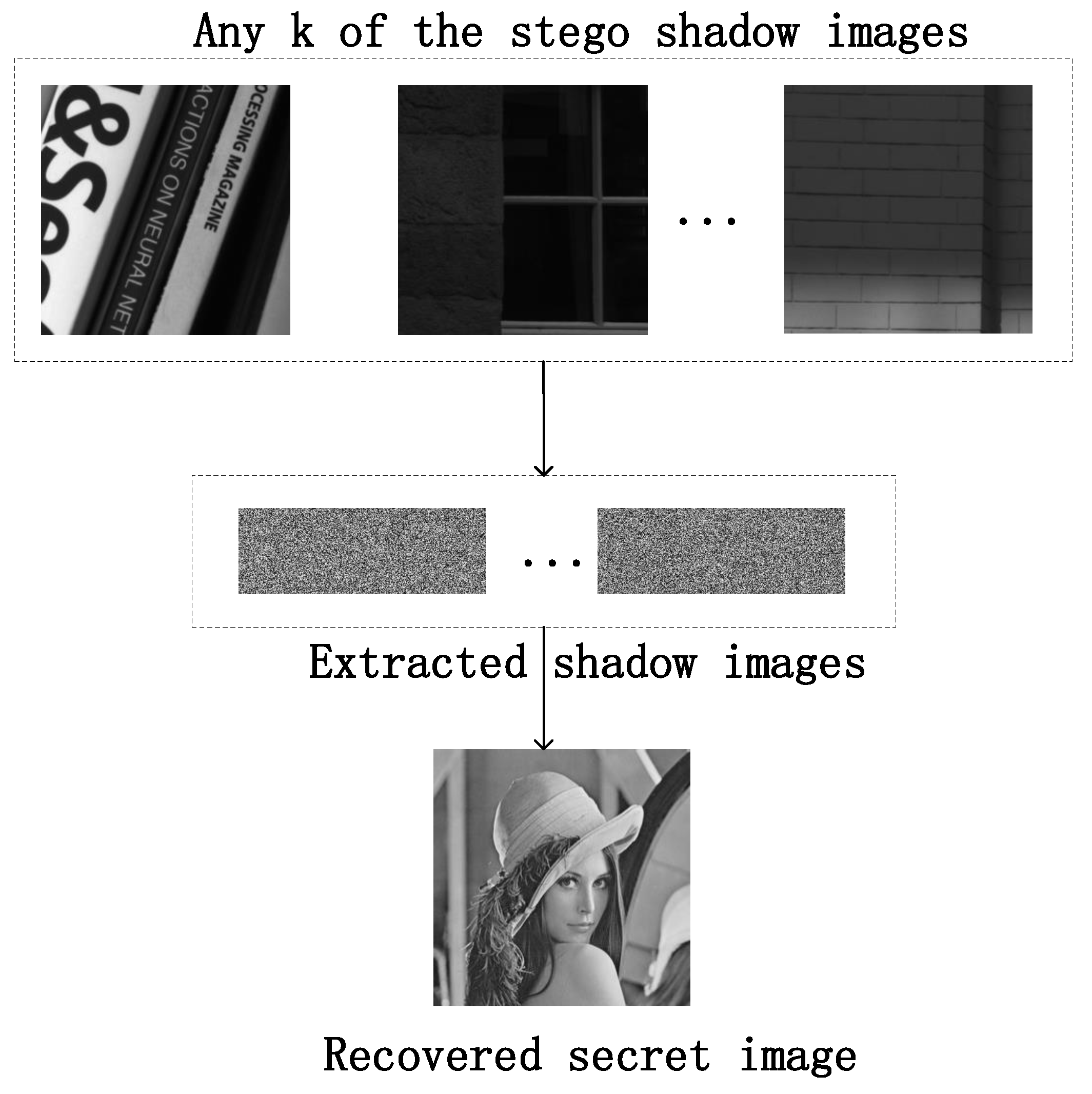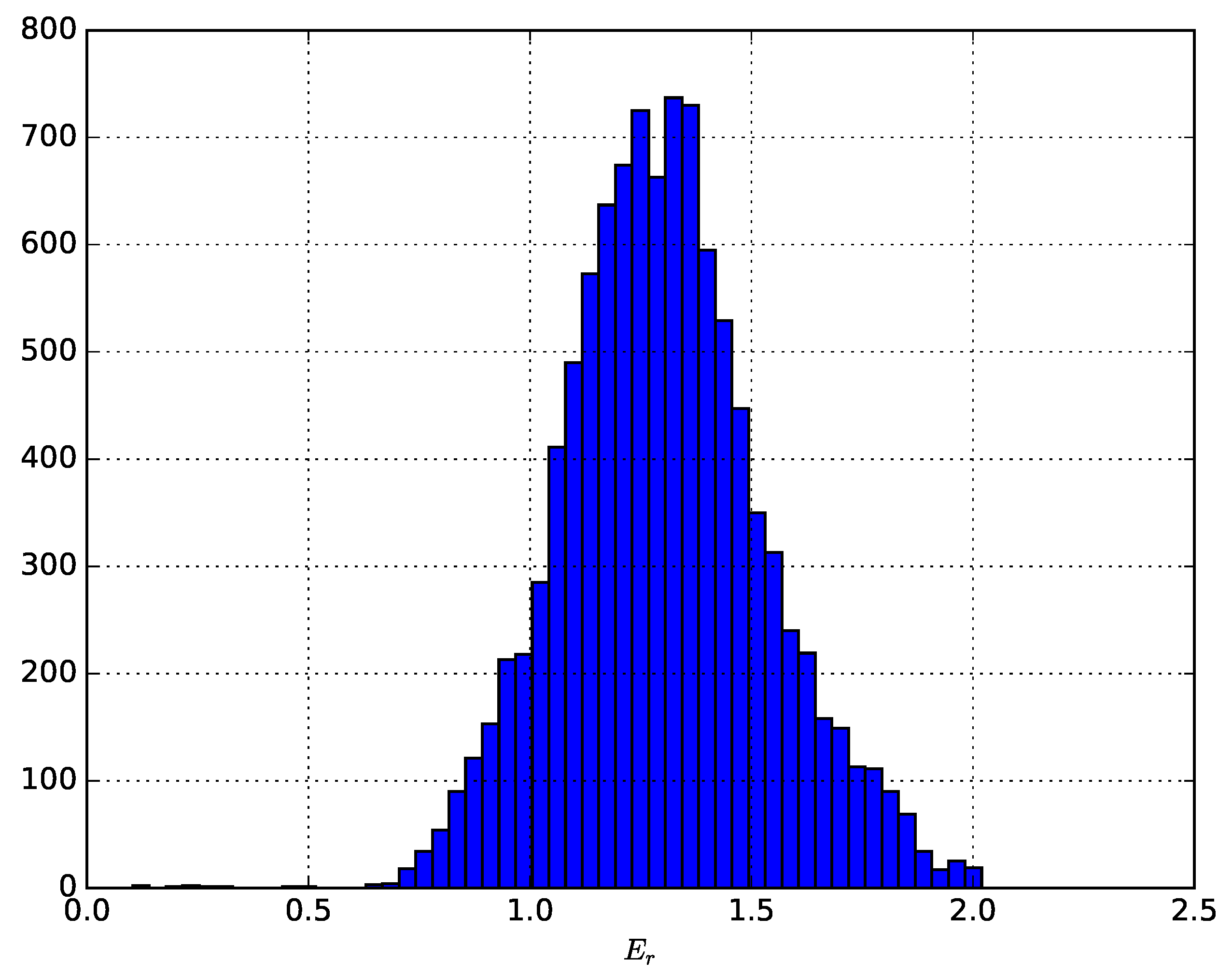Meaningful Secret Image Sharing Scheme with High Visual Quality Based on Natural Steganography
Abstract
1. Introduction
1.1. Secret Image Sharing
1.2. Meaningful Secret Image Sharing Schemes
1.3. Motivations
1.4. The Proposed Method
2. Preliminaries
2.1. Chinese Remainder Theorem-Based Secret Image Sharing with Small-Sized Shadow Images
- .
- .
- for .
- .
- .
- .
2.2. Natural Steganography
- (1)
- Choose the scene to capture, including landscape, portrait, illumination and so on.
- (2)
- Decide the camera to use. The sensor of the camera may be CCD or CMOS. The mode of the sensor can be color or monochrome.
- (3)
- Set the acquisitions of the camera, such as sensitivity, exposure time, white balance, etc.
- (4)
- Develop the original RAW image. Many developing steps can be done before the image output from the camera, containing quantization, downsampling, gamma correction, lossy coding, and so on.
3. The Proposed Meaningful Secret Image Sharing Based on Natural Steganography
3.1. The Proposed Model
3.1.1. Sharing Process
3.1.2. Recovery Process
3.2. Algorithms
3.3. Discussions
- The threshold of MSISS-NS is limited by CRTSIS-SSI, and more details can be referred to [11]
- The embedding rate of NS is larger than other steganography method, and there are various options for embedding. The further experiments and results will be displayed in Section 4.
- The secret image is grayscale image, its file name extension is ‘.bmp’, and the shadow images are also grayscale with ‘.pgm’ as extension. For the same size image, the spaces occupied by the two images are almost the same. For example, when the image is , the ‘.bmp’ image is 257 kb and ‘.pgm’ image is 256 kb.
- In Step 2 of Algorithm 1, the choice of r and k is related to the size of shadow images, which is also restricted by the embedding rate of cover images.
- The embedding method NS comes from [24], but, in Algorithm 1 Step 4, the cost function has been changed, which leads to different embedding rate and detectability results.
- STC is utilized in NS, it approaches the theoretical limit of coding and more details are described in [28].
- In practical operation, it is a challenging issue to capture two images differing only in .
| Algorithm 1 The sharing process of threshold meaningful secret image sharing scheme based on Natural Steganography |
| Input: 1. The secret image S with the size of WH. 2. The set of cover images C with each size of WH. Output: 1. n meaningful shadow images with corresponding privacy modular integers . Step 1: set the initial parameters threshold, a set of integers , and the number of random bits r. Step 2: share the secret image S using CRTSIS-SSI. Get the small-sized shadow images whose size is of S with corresponding privacy modular integers . The parameters , and T produced in the sharing process are all public among all the participants. Step 3: set the initial parameters and of the cover images. Compute the modifications probabilities of each pixel in the cover image for a Q-array embedding. Meanwhile, the embedding rate of each cover image can be output for further selection on the steganography scheme. Step 4: compute the cost on cover image pixels according to subject to: Step 5: embed the small-sized shadow images into the proper cover images using STC. The shadow images embedded should satisfy the conditions, as follows: Step 6: output n meaningful shadow images and their corresponding privacy modular integers . |
| Algorithm 2 The recovery process of threshold meaningful secret image sharing scheme based on Natural Steganography |
| Input: 1. The k meaningful shadow images , corresponding privacy modular integers and the number of bits hidden in every layer . 2. Public parameters p, T and N. Output: The W × H recovered secret image . Step 1: for k meaningful shadow images , repeat Step 2. Step 2: extract the small-sized shadow image from the meaningful shadow image , using the extraction method of STC with the parameters . Step 3: reconstruct the secret image from the k extracted small-sized shadow image using CRTSIS-SSI with the public parameters p, T, and N. |
4. Experimental Results and Summaries
4.1. Image Illustration
4.2. Anti-Steganalysis Experiments
4.3. Comparison with Other Works
4.4. Summaries
- (1)
- The shadow images generated in sharing process by CRTSIS-SSI are random and safe and the detail inference and proof can be accessed in [11].
- (2)
- The shadow images generated by our MSISS-NS are understandable and the visual quality of sharing images is quite better than other similar schemes.
- (3)
- The capability of cover images, which is larger than that in [24], is actually enough to contain the generated small-sized shadow images. Thus no pixel expansion will occur.
- (4)
- Through the experiments above, two kinds of stego images are generated: Stego-MSISS, more similar to Cover-1000; and Stego-add, more similar to Cover-1250. According to the steganalysis results, Stego-MSISS compared with Stego-NS is more similar to Cover-1000. In the two pairs it is difficult to distinguish with each other. It may be because that the payload of NS with STC is really sufficient, and it is difficult to steganalyze the little change.
- (5)
- Nowadays, one of the serious challenges of steganalysis is mismatching. When we put four kinds of images, Cover-1000, Cover-1250, Stego-MSIS and Stegoadd, on the Internet at the same time, it will lead to a more serious mismatch problem and better confuse the judgment of steganalyzers to achieve the purpose of covert communication better.
5. Conclusions
Author Contributions
Funding
Acknowledgments
Conflicts of Interest
References
- Pouli, V.; Kafetzoglou, S.; Tsiropoulou, E.E.; Dimitriou, A.; Papavassiliou, S. Personalized multimedia content retrieval through relevance feedback techniques for enhanced user experience. In Proceedings of the 2015 13th International Conference on Telecommunications (ConTEL), Graz, Austria, 13–15 July 2015. [Google Scholar]
- Shamir, A. How to share a secret. Commun. ACM 1979, 22, 612–613. [Google Scholar] [CrossRef]
- Yang, C.N.; Yu, K.H.; Lukac, R. User-Friendly Image Sharing in Multimedia Database Using Polynomials with Different Primes. In International Conference on Multimedia Modeling, Proceedings of the MMM 2007: Advances in Multimedia Modeling, Singapore, 9–12 January 2007; Lecture Notes in Computer Science (Including Subseries Lecture Notes in Artificial Intelligence and Lecture Notes in Bioinformatics); Springer: Berlin/Heidelberg, Germany, 2007; Volume 4352 LNCS, pp. 443–452. [Google Scholar] [CrossRef]
- Yan, X.; Lu, Y.; Liu, L.; Song, X. Reversible Image Secret Sharing. IEEE Trans. Inf. Forensics Secur. 2020, 15, 3848–3858. [Google Scholar] [CrossRef]
- Naor, M.; Shamir, A. Visual cryptography. In Workshop on the Theory and Application of of Cryptographic Techniques, Proceedings of the EUROCRYPT 1994: Advances in Cryptology—EUROCRYPT’94, Perugia, Italy, 9–12 May 1994; Springer: Berlin/Heidelberg, Germany, 1994; pp. 1–12. [Google Scholar]
- Yang, C.N.; Chen, C.H.; Cai, S.R. Enhanced Boolean-based multi secret image sharing scheme. J. Syst. Softw. 2016, 116, 22–34. [Google Scholar] [CrossRef]
- Mignotte, M. How to Share a Secret. Eurocrypt 1982, 149, 371–375. [Google Scholar]
- Asmuth, C.A.; Bloom, J. A Modular Approach to Key Safeguarding. Inf. Theory IEEE Trans. 1983, 29, 208–210. [Google Scholar] [CrossRef]
- Yan, X.; Lu, Y.; Liu, L.; Wan, S.; Ding, W.; Liu, H. Chinese Remainder Theorem-Based Secret Image Sharing for (k,n) Threshold. In International Conference on Cloud Computing and Security, Proceedings of the ICCCS 2017: Cloud Computing and Security, Kracow, Poland, 11–14 July 2017; Springer: Cham, Switzerland, 2017; pp. 433–440. [Google Scholar]
- Li, L.; Lu, Y.; Yan, X.; Liu, L.; Tan, L. Lossless (k,n)-Threshold Image Secret Sharing Based on the Chinese Remainder Theorem Without Auxiliary Encryption. IEEE Access 2019, 7, 75113–75121. [Google Scholar] [CrossRef]
- Chen, J.; Liu, K.; Yan, X.; Liu, L.; Zhou, X.; Tan, L. Chinese remainder theorem-based secret image sharing with small-sized shadow images. Symmetry 2018, 10, 340. [Google Scholar] [CrossRef]
- Ateniese, G.; Blundo, C.; Santis, A.D.; Stinson, D.R. Extended capabilities for visual cryptography. Theor. Comput. Sci. 2001, 250, 143–161. [Google Scholar] [CrossRef]
- Zhou, Z.; Mu, Y.; Wu, Q.M.J. Coverless image steganography using partial-duplicate image retrieval. Soft Comput. 2018. [Google Scholar] [CrossRef]
- Yan, X.; Lu, Y.; Liu, L. General Meaningful Shadow Construction in Secret Image Sharing. IEEE Access 2018, 6, 45246–45255. [Google Scholar] [CrossRef]
- Lin, C.C.; Tsai, W.H. Secret image sharing with steganography and authentication. J. Syst. Softw. 2004, 73, 405–414. [Google Scholar] [CrossRef]
- Li, P.; Kong, Q.; Ma, Y. Image Secret Sharing and Hiding with Authentication Based on PSNR Estimation. J. Inf. Hiding Multimed. Signal Process. 2014, 5, 353–366. [Google Scholar]
- Yuan, H.D. Secret sharing with multi-cover adaptive steganography. Inf. Sci. 2014, 254, 197–212. [Google Scholar] [CrossRef]
- Avci, D. A novel meaningful secret image sharing method based on Arabic letters. Kuwait J. Sci. 2016, 43. [Google Scholar]
- Cheng, T.F.; Chang, C.C.; Liu, L. Secret sharing: Using meaningful image shadows based on Gray code. Multimed. Tools Appl. 2017, 76, 1–26. [Google Scholar] [CrossRef]
- He, J.; Lan, W.; Tang, S. A secure image sharing scheme with high quality stego-images based on steganography. Multimed. Tools Appl. 2017, 76, 7677–7698. [Google Scholar] [CrossRef]
- Chiu, P.L.; Lee, K.H. Efficient constructions for progressive visual cryptography with meaningful shares. Signal Process. 2019, 165, 233–249. [Google Scholar] [CrossRef]
- Maurya, R.; Kannojiya, A.K.; Rajitha, B. An Extended Visual Cryptography Technique for Medical Image Security. In Proceedings of the 2020 2nd International Conference on Innovative Mechanisms for Industry Applications (ICIMIA), Bangalore, India, 5–7 March 2020; pp. 415–421. [Google Scholar]
- Hassanien, A.E.; Azar, A.T.; Snasael, V.; Kacprzyk, J.; Abawajy, J.H. Big data in complex systems. In SBD; Springer: Berlin/Heidelberg, Germany, 2015; Volume 9. [Google Scholar]
- Bas, P. Steganography via cover-source switching. In Proceedings of the 2016 IEEE International Workshop on Information Forensics and Security (WIFS), Abu Dhabi, UAE, 4–7 December 2016. [Google Scholar]
- Bas, P.; Filler, T.; Pevn, T. “Break Our Steganographic System”: The Ins and Outs of Organizing BOSS. In Proceedings of the Information Hiding—13th International Conference, IH 2011, Prague, Czech Republic, 18–20 May 2011. Revised Selected Papers. [Google Scholar]
- Denemark, T.; Fridrich, J. Side-informed steganography with additive distortion. In Proceedings of the 2015 IEEE International Workshop on Information Forensics and Security (WIFS), Rome, Italy, 16–19 November 2015; pp. 1–6. [Google Scholar]
- Foi, A.; Alenius, S.; Katkovnik, V.; Egiazarian, K. Noise measurement for raw-data of digital imaging sensors by automatic segmentation of nonuniform targets. IEEE Sens. J. 2007, 7, 1456–1461. [Google Scholar] [CrossRef]
- Filler, T.; Judas, J.; Fridrich, J. Minimizing Additive Distortion in Steganography Using Syndrome-Trellis Codes. IEEE Trans. Inf. Forensics Secur. 2011, 6, 920–935. [Google Scholar] [CrossRef]
- Bas, P. Monobase. Available online: http://patrickbas.ec-lille.fr/MonoBase/ (accessed on 22 July 2016).
- Fridrich, J.; Kodovsky, J. Rich models for steganalysis of digital images. IEEE Trans. Inf. Forensics Secur. 2012, 7, 868–882. [Google Scholar] [CrossRef]
- Kodovsky, J.; Fridrich, J.; Holub, V. Ensemble classifiers for steganalysis of digital media. IEEE Trans. Inf. Forensics Secur. 2011, 7, 432–444. [Google Scholar] [CrossRef]






| Compared with Cover Images with 1000 | Compared with Cover Images with 1250 | |||
|---|---|---|---|---|
| PSNR | SSIM | SPNR | SSIM | |
| 71.75 | 0.9999 | 27.79 | 0.9995 | |
| 79.93 | 0.9999 | 30.79 | 0.9989 | |
| 76.75 | 0.9999 | 45.94 | 0.9999 | |
| 78.66 | 0.9999 | 39.50 | 0.9977 | |
| Means | 76.77 | 0.9999 | 36.01 | 0.9990 |
| Compared with Cover Images with 1000 | Compared with Cover Images with 1250 | |||
|---|---|---|---|---|
| PSNR | SSIM | SPNR | SSIM | |
| Means | 78.0787 | 0.9999 | 38.4145 | 0.9952 |
| Stego-NS | Stego-MSISS | ||
|---|---|---|---|
| Cover-1250 | 44.33% | 30.23% | |
| Cover-1000 | 23.50% | 45.12% |
| Stego-Add | Stego-Ran | ||
|---|---|---|---|
| Cover-1250 | 39.44% | 39.57% | |
| Cover-1000 | 20.64% | 20.44% |
| Stego-NS | Stego-MSISS | Stego-Add | Stego-Ran |
|---|---|---|---|
| 27.7% | 44.84% | 43.97% |
| Stego-MSISS | Stego-Add | Stego-Ran |
|---|---|---|
| 24.46% | 24.33% |
| Stego-Add | Stego-Ran |
|---|---|
| 50.01% |
| Methods | Threshold | Secret Images | Shadow Images | Lossless Recovery | Pixel Expansion | Anti-Steganalysis |
|---|---|---|---|---|---|---|
| Li [16] | Grayscale | Grayscale | Yes | Yes | Not referred | |
| Yuan [17] | Two-tone or four-tone image | Grayscale | Yes | Yes | Yes | |
| He [20] | Grayscale | Grayscale | Yes | Yes | Not referred | |
| Cheng [19] | Grayscale | Grayscale | No | No | Not referred | |
| Chiu [21] | Binary Image | Binary Image | Progressive | No | Not referred | |
| Maurya [22] | Grayscale | Grayscale or color images | Yes | Yes | Not referred | |
| Our Method | Grayscale | Grayscale | Yes | No | Yes |
© 2020 by the authors. Licensee MDPI, Basel, Switzerland. This article is an open access article distributed under the terms and conditions of the Creative Commons Attribution (CC BY) license (http://creativecommons.org/licenses/by/4.0/).
Share and Cite
Sun, Y.; Lu, Y.; Chen, J.; Zhang, W.; Yan, X. Meaningful Secret Image Sharing Scheme with High Visual Quality Based on Natural Steganography. Mathematics 2020, 8, 1452. https://doi.org/10.3390/math8091452
Sun Y, Lu Y, Chen J, Zhang W, Yan X. Meaningful Secret Image Sharing Scheme with High Visual Quality Based on Natural Steganography. Mathematics. 2020; 8(9):1452. https://doi.org/10.3390/math8091452
Chicago/Turabian StyleSun, Yuyuan, Yuliang Lu, Jinrui Chen, Weiming Zhang, and Xuehu Yan. 2020. "Meaningful Secret Image Sharing Scheme with High Visual Quality Based on Natural Steganography" Mathematics 8, no. 9: 1452. https://doi.org/10.3390/math8091452
APA StyleSun, Y., Lu, Y., Chen, J., Zhang, W., & Yan, X. (2020). Meaningful Secret Image Sharing Scheme with High Visual Quality Based on Natural Steganography. Mathematics, 8(9), 1452. https://doi.org/10.3390/math8091452





